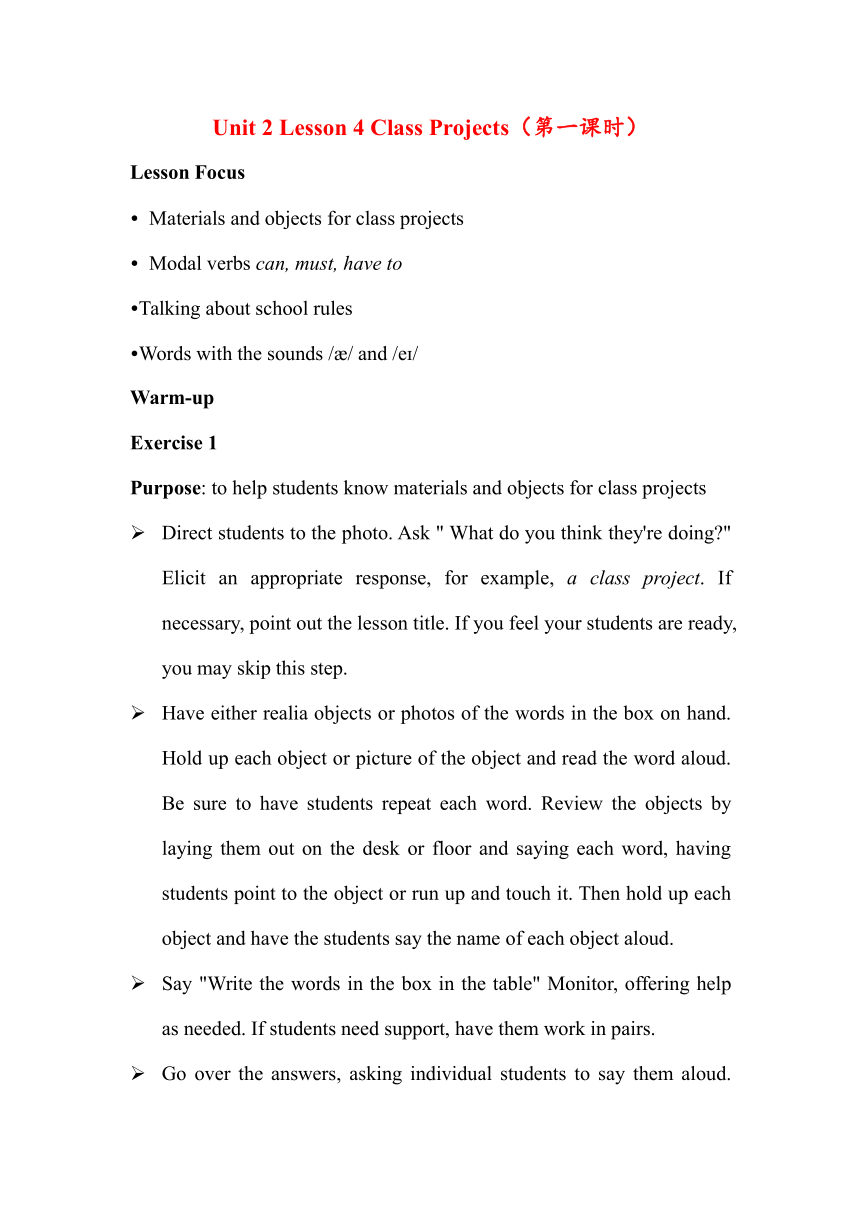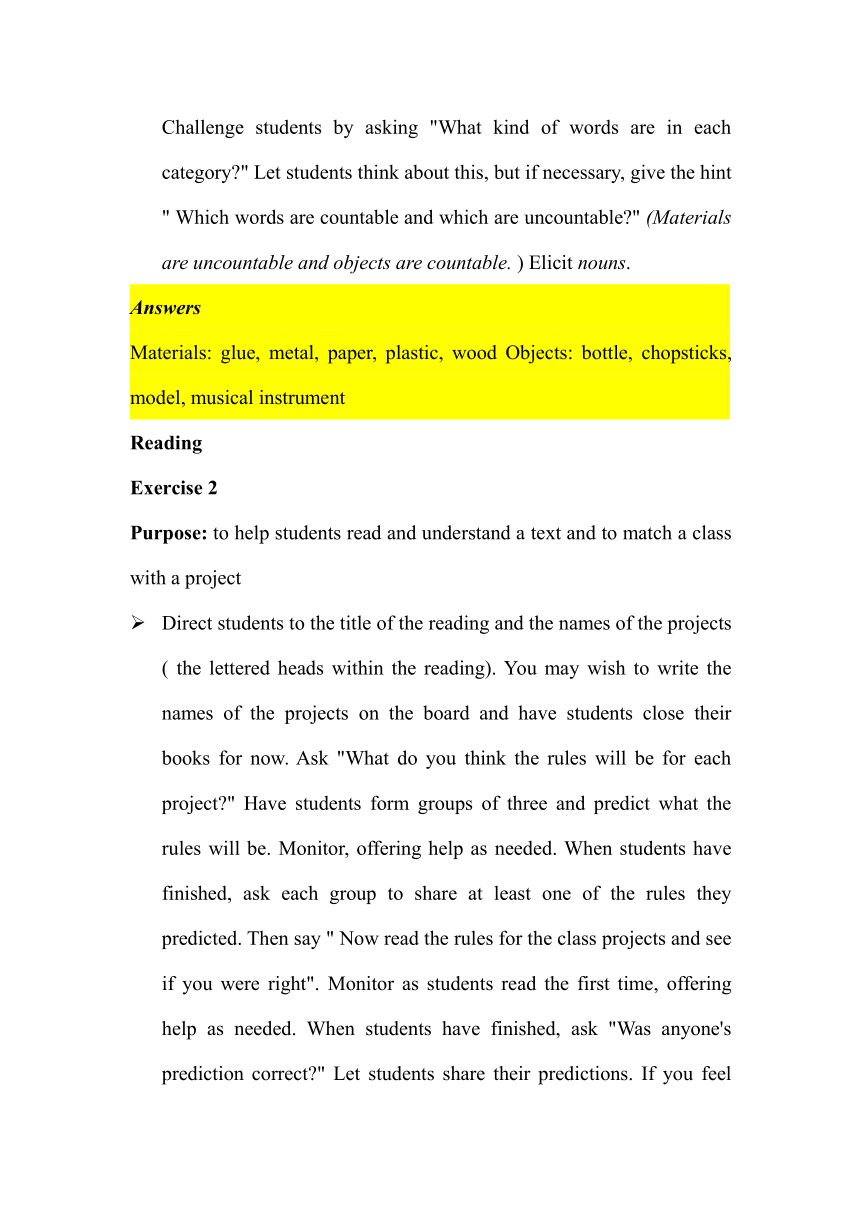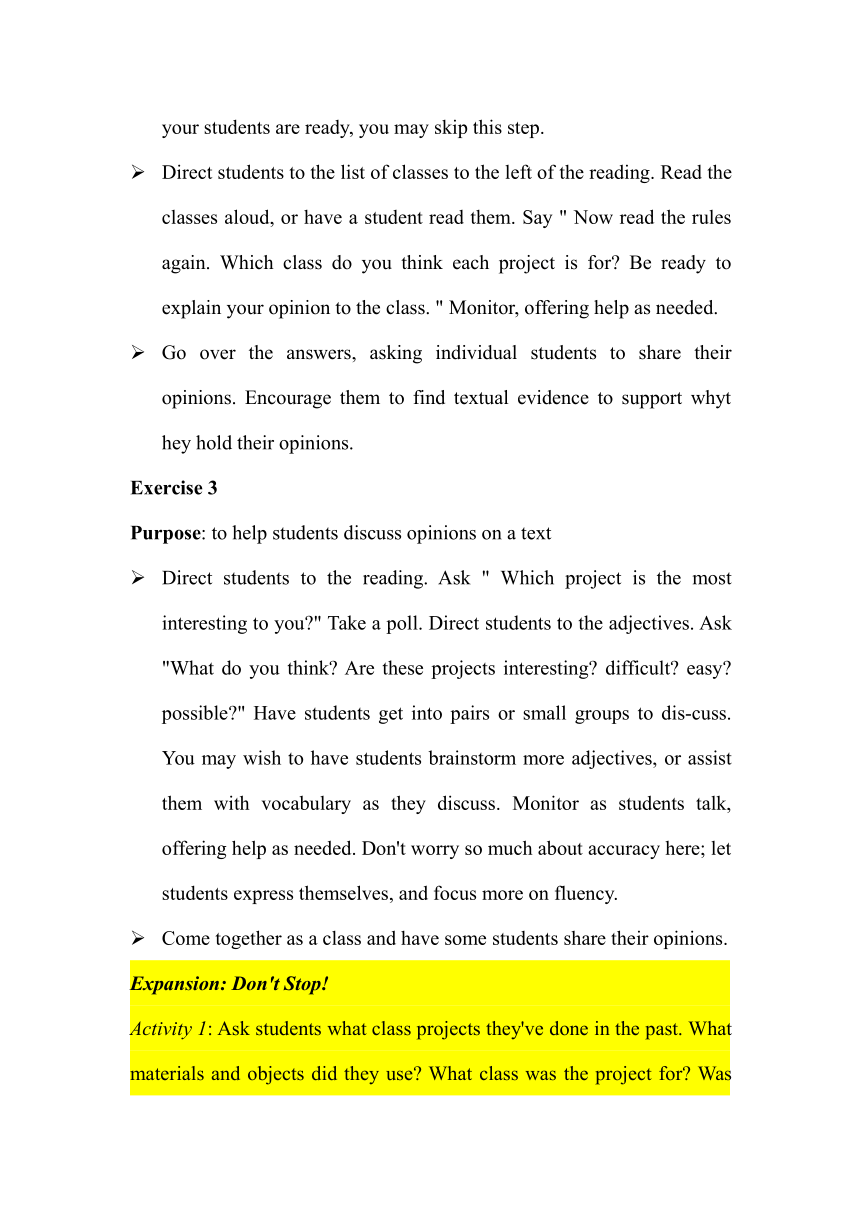Unit 2 Lesson 4 Class Projects Lesson 4 Class Projects 第一课时 教学设计
文档属性
| 名称 | Unit 2 Lesson 4 Class Projects Lesson 4 Class Projects 第一课时 教学设计 |  | |
| 格式 | docx | ||
| 文件大小 | 21.9KB | ||
| 资源类型 | 教案 | ||
| 版本资源 | 北师大版 | ||
| 科目 | 英语 | ||
| 更新时间 | 2023-12-08 20:05:47 | ||
图片预览



文档简介
Unit 2 Lesson 4 Class Projects(第一课时)
Lesson Focus
Materials and objects for class projects
Modal verbs can, must, have to
Talking about school rules
Words with the sounds / / and /e /
Warm-up
Exercise 1
Purpose: to help students know materials and objects for class projects
Direct students to the photo. Ask " What do you think they're doing " Elicit an appropriate response, for example, a class project. If necessary, point out the lesson title. If you feel your students are ready, you may skip this step.
Have either realia objects or photos of the words in the box on hand. Hold up each object or picture of the object and read the word aloud. Be sure to have students repeat each word. Review the objects by laying them out on the desk or floor and saying each word, having students point to the object or run up and touch it. Then hold up each object and have the students say the name of each object aloud.
Say "Write the words in the box in the table" Monitor, offering help as needed. If students need support, have them work in pairs.
Go over the answers, asking individual students to say them aloud. Challenge students by asking "What kind of words are in each category " Let students think about this, but if necessary, give the hint " Which words are countable and which are uncountable " (Materials are uncountable and objects are countable. ) Elicit nouns.
Answers
Materials: glue, metal, paper, plastic, wood Objects: bottle, chopsticks, model, musical instrument
Reading
Exercise 2
Purpose: to help students read and understand a text and to match a class with a project
Direct students to the title of the reading and the names of the projects ( the lettered heads within the reading). You may wish to write the names of the projects on the board and have students close their books for now. Ask "What do you think the rules will be for each project " Have students form groups of three and predict what the rules will be. Monitor, offering help as needed. When students have finished, ask each group to share at least one of the rules they predicted. Then say " Now read the rules for the class projects and see if you were right". Monitor as students read the first time, offering help as needed. When students have finished, ask "Was anyone's prediction correct " Let students share their predictions. If you feel your students are ready, you may skip this step.
Direct students to the list of classes to the left of the reading. Read the classes aloud, or have a student read them. Say " Now read the rules again. Which class do you think each project is for Be ready to explain your opinion to the class. " Monitor, offering help as needed.
Go over the answers, asking individual students to share their opinions. Encourage them to find textual evidence to support whyt hey hold their opinions.
Exercise 3
Purpose: to help students discuss opinions on a text
Direct students to the reading. Ask " Which project is the most interesting to you " Take a poll. Direct students to the adjectives. Ask "What do you think Are these projects interesting difficult easy possible " Have students get into pairs or small groups to dis-cuss. You may wish to have students brainstorm more adjectives, or assist them with vocabulary as they discuss. Monitor as students talk, offering help as needed. Don't worry so much about accuracy here; let students express themselves, and focus more on fluency.
Come together as a class and have some students share their opinions.
Expansion: Don't Stop!
Activity 1: Ask students what class projects they've done in the past. What materials and objects did they use What class was the project for Was the project successful Did they enjoy doing it Was it interesting difficult easy Would they do it again, or would they change the project Have students discuss these questions in small groups if classroom management doesn't allow you to discuss it as a class.
Activity 2: Ask students to do the projects in the Student Book. Each student can sign up for the project he or she is most interested in, but try to have an even number of students for each project. Either provide the materials and objects yourself, or ask students to bring some in. If students have another idea for a project, or wish to vary the project, tell them to consult with you first. Have one or two classes for making the project, and one class for presenting the project. There is one more rule: The presentations must be in English, of course!
Grammar: Modal verbs can, must, have to
Exercise 4
Purpose: to help students complete school rules with can / can't or have to / don't have to
Direct students to the reading. Say "Read the school rules for Project a". Elicit the rules and write them, or parts of them, on the board: You (can) use wood. You (mustn't) use other things. You (don't have to) paint the model. You (must) describe your building. It (doesn't have to) be long. Ask "What are the verbs in each rule " Elicit or provide use, use, paint, describe, be, and underline each as shown here. Circle the modal verbs. Explain that the underlined verb in each rule is the action of the sentence. The circled verb is the modal verb, or "helping verb". Helping verbs express time and mood. Point out that with helping verbs, we use the base form, not the infinitive. For example, I don't like tea. He didn't go. We will study harder. It has to fly for ten seconds. (NOTE: has to is the modal, not has. )
Ask students to think of other helping verbs, for example, do and don't, Explain that the helping verb do / does indicates a question or short answer in the present tense. Don't / doesn't indicates a negative. Did / didn't indicates the past tense, etc. Provide or elicit examples if necessary. Explain that modal verbs are a special kind of helping verb. A modal verb that students are already familiar with is will, which is used to express the future, as in We will finish at 5: 00. Point out that modal verbs, like other helping verbs, are also al used with the base form of the action verb. Point out that the third-person form doesn't pare: I don't swim and he doesn't swim. BUT I can't go and he can't go.
Explain that the modal verb can is used to express something you are or aren't allowed to do. (You can use paper and glue but you can't use metal.) Explain that the modal verbs must and have to express something you are obliged to do. (You must / have to play the film in class. ) When used in the negative, the modal verb don't / doesn't have to means you are not obliged to do something. ( You don't have to paint the model. ) However, the modal verb mustn't means you are not allowed to do it. (You musn't use other things. ) Point out that can and must in the negative take not, while have to takes don't or doesn't.
Give students more practice in identifying modal verbs and their uses. Ask them to work in pairs to find other examples in the reading, or have them read the list in the Grammar exercise. Ask them to rephrase the sentences, or to translate them, using (not) allowed and (not) obliged.
Direct students to the sentences. Say " Now complete the school rules with can / can't or have to / don't have to". Monitor, offering help as needed. If students need support, have them work in pairs.
Go over the answers, having individual students read the sentences aloud.
Answers
1. can't, have to; 2. can, have to;
3. can, can't; 4. have to, can;
5. can, can't; 6. can, can't
Lesson Focus
Materials and objects for class projects
Modal verbs can, must, have to
Talking about school rules
Words with the sounds / / and /e /
Warm-up
Exercise 1
Purpose: to help students know materials and objects for class projects
Direct students to the photo. Ask " What do you think they're doing " Elicit an appropriate response, for example, a class project. If necessary, point out the lesson title. If you feel your students are ready, you may skip this step.
Have either realia objects or photos of the words in the box on hand. Hold up each object or picture of the object and read the word aloud. Be sure to have students repeat each word. Review the objects by laying them out on the desk or floor and saying each word, having students point to the object or run up and touch it. Then hold up each object and have the students say the name of each object aloud.
Say "Write the words in the box in the table" Monitor, offering help as needed. If students need support, have them work in pairs.
Go over the answers, asking individual students to say them aloud. Challenge students by asking "What kind of words are in each category " Let students think about this, but if necessary, give the hint " Which words are countable and which are uncountable " (Materials are uncountable and objects are countable. ) Elicit nouns.
Answers
Materials: glue, metal, paper, plastic, wood Objects: bottle, chopsticks, model, musical instrument
Reading
Exercise 2
Purpose: to help students read and understand a text and to match a class with a project
Direct students to the title of the reading and the names of the projects ( the lettered heads within the reading). You may wish to write the names of the projects on the board and have students close their books for now. Ask "What do you think the rules will be for each project " Have students form groups of three and predict what the rules will be. Monitor, offering help as needed. When students have finished, ask each group to share at least one of the rules they predicted. Then say " Now read the rules for the class projects and see if you were right". Monitor as students read the first time, offering help as needed. When students have finished, ask "Was anyone's prediction correct " Let students share their predictions. If you feel your students are ready, you may skip this step.
Direct students to the list of classes to the left of the reading. Read the classes aloud, or have a student read them. Say " Now read the rules again. Which class do you think each project is for Be ready to explain your opinion to the class. " Monitor, offering help as needed.
Go over the answers, asking individual students to share their opinions. Encourage them to find textual evidence to support whyt hey hold their opinions.
Exercise 3
Purpose: to help students discuss opinions on a text
Direct students to the reading. Ask " Which project is the most interesting to you " Take a poll. Direct students to the adjectives. Ask "What do you think Are these projects interesting difficult easy possible " Have students get into pairs or small groups to dis-cuss. You may wish to have students brainstorm more adjectives, or assist them with vocabulary as they discuss. Monitor as students talk, offering help as needed. Don't worry so much about accuracy here; let students express themselves, and focus more on fluency.
Come together as a class and have some students share their opinions.
Expansion: Don't Stop!
Activity 1: Ask students what class projects they've done in the past. What materials and objects did they use What class was the project for Was the project successful Did they enjoy doing it Was it interesting difficult easy Would they do it again, or would they change the project Have students discuss these questions in small groups if classroom management doesn't allow you to discuss it as a class.
Activity 2: Ask students to do the projects in the Student Book. Each student can sign up for the project he or she is most interested in, but try to have an even number of students for each project. Either provide the materials and objects yourself, or ask students to bring some in. If students have another idea for a project, or wish to vary the project, tell them to consult with you first. Have one or two classes for making the project, and one class for presenting the project. There is one more rule: The presentations must be in English, of course!
Grammar: Modal verbs can, must, have to
Exercise 4
Purpose: to help students complete school rules with can / can't or have to / don't have to
Direct students to the reading. Say "Read the school rules for Project a". Elicit the rules and write them, or parts of them, on the board: You (can) use wood. You (mustn't) use other things. You (don't have to) paint the model. You (must) describe your building. It (doesn't have to) be long. Ask "What are the verbs in each rule " Elicit or provide use, use, paint, describe, be, and underline each as shown here. Circle the modal verbs. Explain that the underlined verb in each rule is the action of the sentence. The circled verb is the modal verb, or "helping verb". Helping verbs express time and mood. Point out that with helping verbs, we use the base form, not the infinitive. For example, I don't like tea. He didn't go. We will study harder. It has to fly for ten seconds. (NOTE: has to is the modal, not has. )
Ask students to think of other helping verbs, for example, do and don't, Explain that the helping verb do / does indicates a question or short answer in the present tense. Don't / doesn't indicates a negative. Did / didn't indicates the past tense, etc. Provide or elicit examples if necessary. Explain that modal verbs are a special kind of helping verb. A modal verb that students are already familiar with is will, which is used to express the future, as in We will finish at 5: 00. Point out that modal verbs, like other helping verbs, are also al used with the base form of the action verb. Point out that the third-person form doesn't pare: I don't swim and he doesn't swim. BUT I can't go and he can't go.
Explain that the modal verb can is used to express something you are or aren't allowed to do. (You can use paper and glue but you can't use metal.) Explain that the modal verbs must and have to express something you are obliged to do. (You must / have to play the film in class. ) When used in the negative, the modal verb don't / doesn't have to means you are not obliged to do something. ( You don't have to paint the model. ) However, the modal verb mustn't means you are not allowed to do it. (You musn't use other things. ) Point out that can and must in the negative take not, while have to takes don't or doesn't.
Give students more practice in identifying modal verbs and their uses. Ask them to work in pairs to find other examples in the reading, or have them read the list in the Grammar exercise. Ask them to rephrase the sentences, or to translate them, using (not) allowed and (not) obliged.
Direct students to the sentences. Say " Now complete the school rules with can / can't or have to / don't have to". Monitor, offering help as needed. If students need support, have them work in pairs.
Go over the answers, having individual students read the sentences aloud.
Answers
1. can't, have to; 2. can, have to;
3. can, can't; 4. have to, can;
5. can, can't; 6. can, can't
同课章节目录
- Unit 1 Television
- Lesson 1 Last Week on TV
- Lesson 2 An Interview on TV
- Lesson 3 The Big Game
- Communication Workshop
- Unit 2 Teams
- Lesson 4 Class Projects
- Lesson 5 Teamwork
- Lesson 6 A Special Team
- Communication Workshop
- Unit 3 Faster,Higher,Stronge
- Lesson 7 Time to Exercise
- Lesson 8 Olympic Winners
- Lesson 9 Never Give Up!
- Communication Workshop
- Unit 4 Healthy Living
- Lesson 10 Going to the Doctor
- Lesson 11 Health Advice
- Lesson 12 Healthy Bones
- Communication Workshop
- Unit 5 Helping
- Lesson 13 Helping Your Community
- Lesson 14 Helping Each Other
- Lesson 15 A Young Hero
- Communication Workshop
- Unit 6 The Unexplained
- Lesson 16 Natural Abilities
- Lesson 17 True Stories?
- Lesson 18 Dreams
- Communication Workshop
